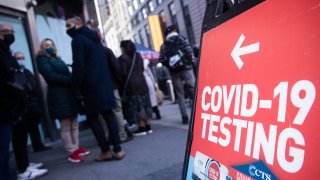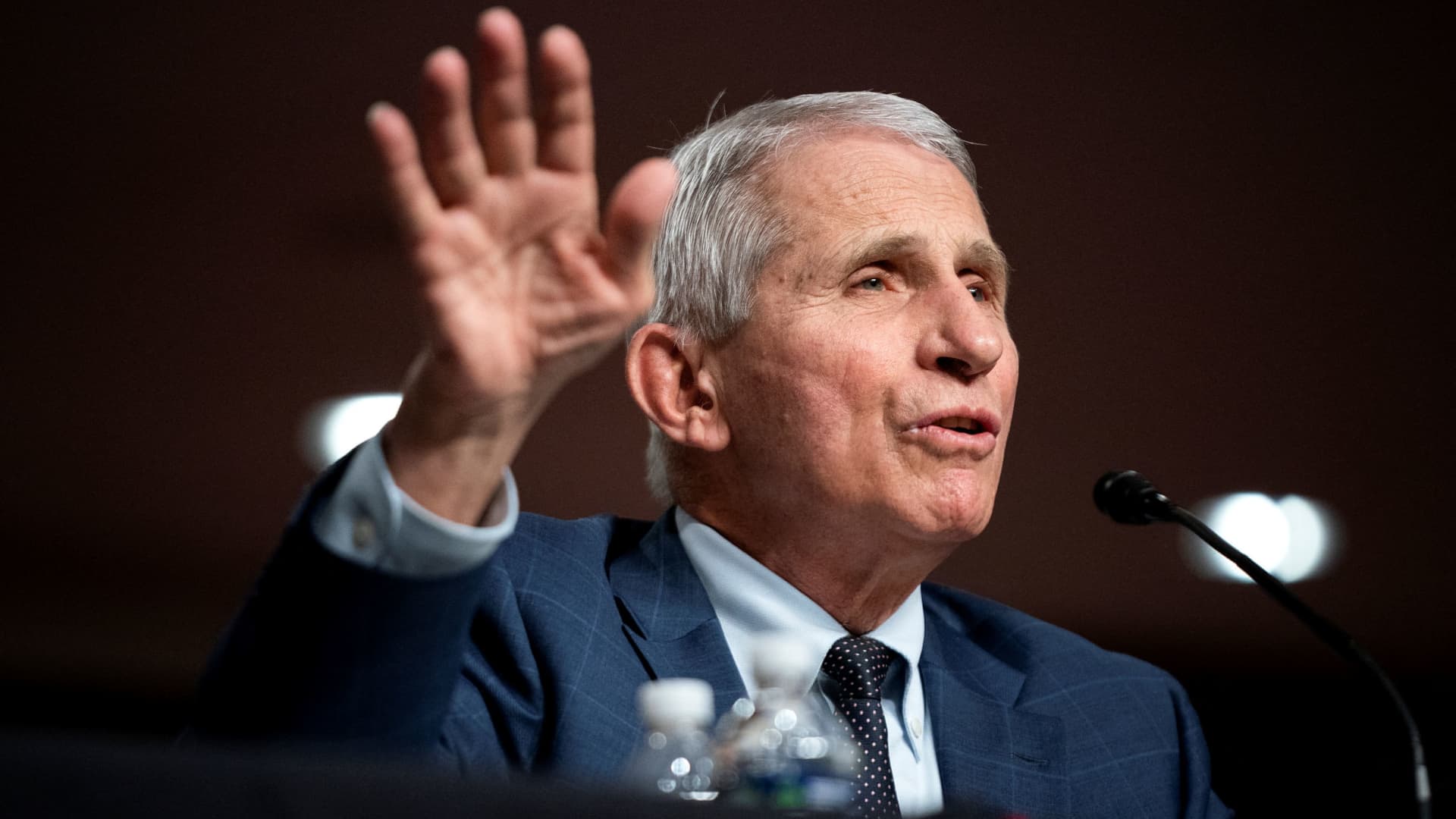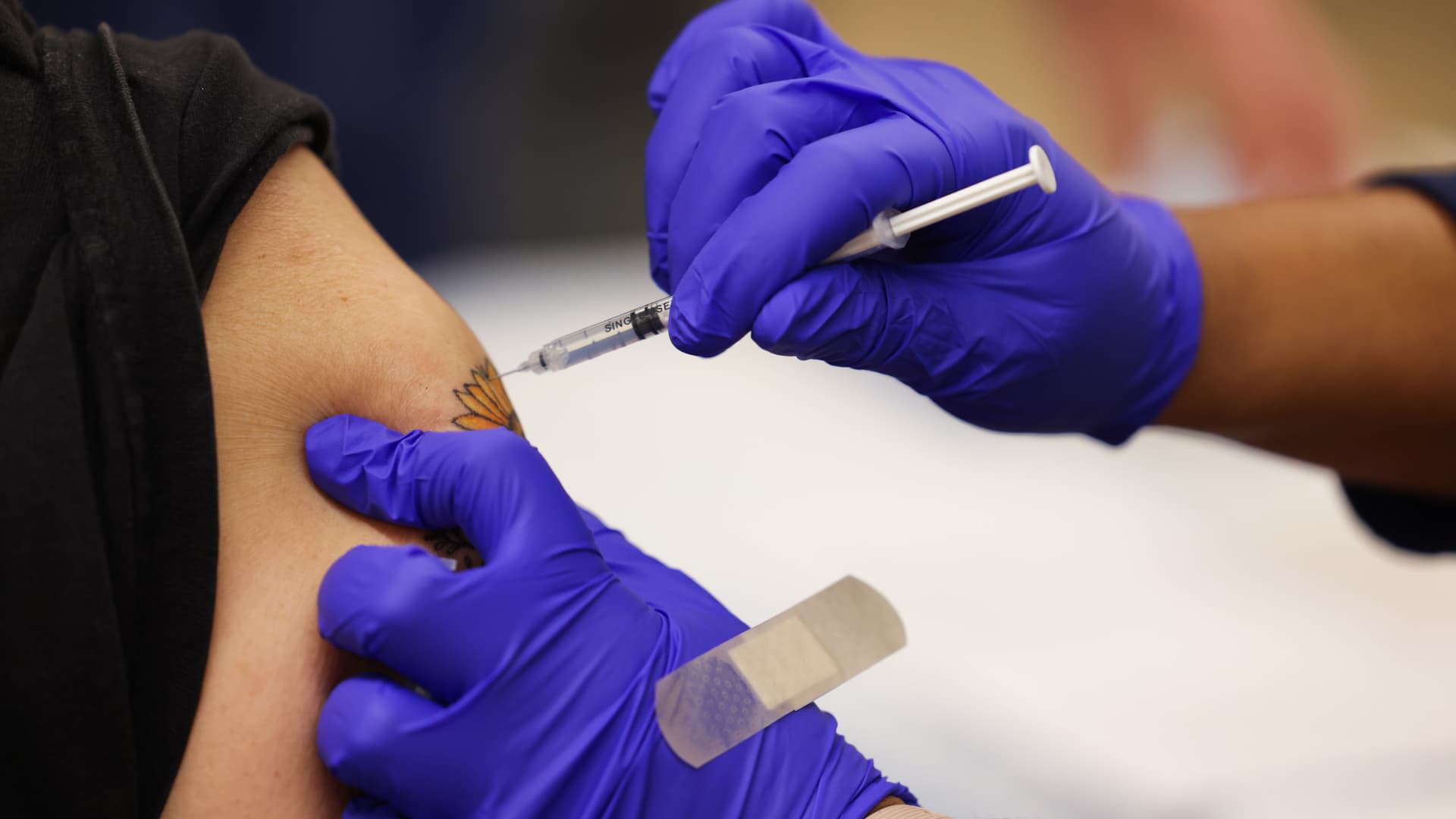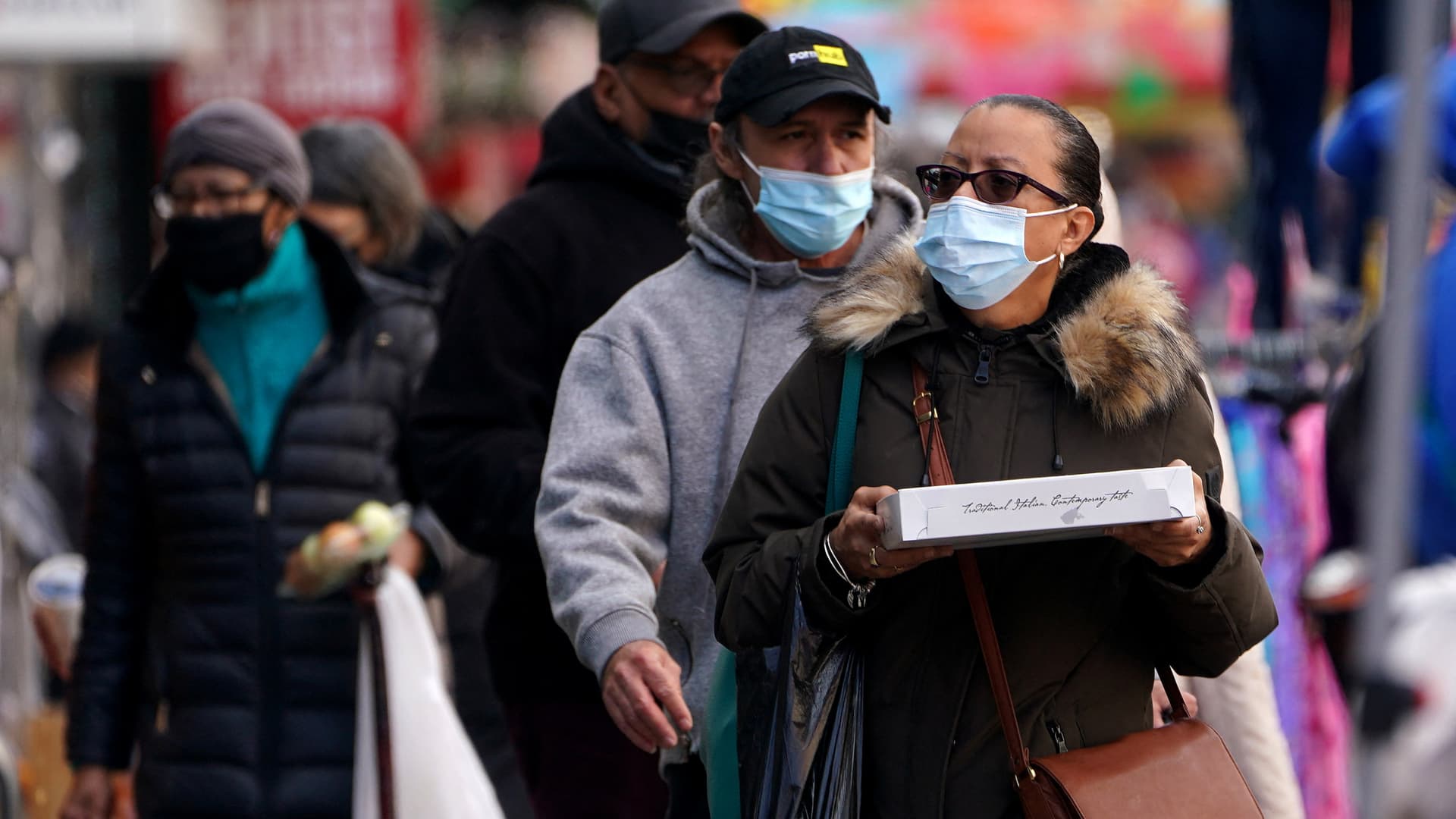
- The World Health Organization generally defines pandemic as uncontrolled spread of a virus across the globe, and an epidemic is when the spread is limited to a country or region.
- A steady level of transmission that doesn't result in a widespread outbreak is generally considered endemic.
Senior U.S. health officials have sought to reassure a pandemic-weary public that the country is moving closer to a time when Covid-19 won't dominate our daily lives, as an unprecedented surge of infections and hospitalizations declines in many parts of the country.
WATCH ANYTIME FOR FREE
Stream NBC10 Boston news for free, 24/7, wherever you are. |
White House chief medical advisor Dr. Anthony Fauci said in an interview this week the U.S. is heading out of the "full-blown pandemic phase" of Covid-19. Fauci has made clear the U.S. won't eradicate Covid, but he's confident the nation can bring the virus under control so it no longer threatens to push hospitals to their breaking point or disrupt the economy. At that moment, people could return to a semblance of normal life after two years of disruption and uncertainty following repeated waves of infection.
Get updates on what's happening in Boston to your inbox. Sign up for our News Headlines newsletter.
"The president has been clear that we're moving toward a time when Covid won't disrupt our daily lives, a time when Covid won't be a constant crisis so we're no longer fearing lockdowns and shutdowns, but getting back to safely doing what we all love," Jeff Zients, the White House's Covid response coordinator, said during a news conference Wednesday.

More mild
Money Report
Real-world studies from around the globe have demonstrated that the omicron variant, though more contagious, generally doesn't make people as sick as delta. While infections have skyrocketed, hospitalizations and deaths have not risen at the same rate.
Doctors and infectious disease experts in South Africa, in a recent study, said the variant's rapid surge and decline in that country demonstrated a significantly different trajectory than past strains. They say it could be a sign the pandemic will transition into an endemic phase that is less disruptive to society.
"Endemic in general means where you have disease that occurs at a regular and predictable level," said Dr. James Lawler, an infectious disease expert at the University of Nebraska. "There's endemic flu and then there's epidemics of flu every season. Those epidemics generally are predictable and occur within a forecasted range."
There isn't a precise definition of endemic. The World Health Organization generally defines pandemic as uncontrolled spread of a virus across the globe, and an epidemic is when the spread is limited to a country or region. A steady level of transmission that doesn't result in a widespread outbreak is generally considered endemic.

What is endemic
This steady level of transmission is typically reached when the virus's reproductive rate is one or less. That means everyone who gets the virus infects roughly one other person. The original Covid strain had a reproductive rate of about two, while people with delta typically infected five or more other people, according to the Centers for Disease Control and Prevention. Omicron is estimated to be more than three times as contagious as delta, according to a study by Japanese researchers.
The emergence of omicron, with its ability to infect people who are vaccinated and even boosted, has challenged notions of when a sustained endemic phase will come and what it will look like in the context of Covid. Though estimates range, a study by public health authorities in Denmark found that omicron was 2.7 to 3.7 times more transmissible than delta among people fully vaccinated, making it easier for the virus to cause outbreaks even in populations with high immunization rates.
Omicron has also proven adept at reinfecting people, with a recent study in the U.K. finding that two-thirds of people who caught the variant said they had Covid before. This makes herd immunity even more elusive than originally thought. In the first year of the pandemic, government officials hoped of the global vaccination campaign would help eradicate Covid by reaching herd immunity, where enough people have natural or vaccine-induced protection that the virus doesn't have new hosts to infect.
Herd immunity
"The notion of natural herd immunity without vaccination is a scientific untruth," according to Ottar Bjornstad, a professor at Pennsylvania State University who researches disease outbreaks. Though breakthrough infections have become common with omicron, the vaccinated shed less of the virus than people who haven't gotten their shots, he said. Most importantly, the vaccines remain effective at preventing severe disease and death, which is crucial to restoring normal life.
As the effectiveness of the first-two vaccine doses subsides, booster shots have become critical to taming the pandemic. Pfizer and BioNTech's booster shot, for example, is up to 75% effective at preventing symptomatic infection, or illness, according to data from the U.K. Health Security Agency.

"If everybody who was eligible for a third dose got a third dose, and eventually we'll probably need to start giving fourth doses, if we were able to do that we'd be done — pandemic emergency over," Lawler said.
The U.S., however, is nowhere close to that level of booster uptake. Only 64% of the U.S. population is fully vaccinated and just 42% of those people have received a third shot, according to the CDC. And tens of millions of Americans still are not vaccinated at all.
Hope
There is a hope, however, that between vaccination and mass exposure to omicron, there will be enough immunity in the population that the number of people susceptible to falling ill from the virus rapidly diminishes as the latest wave subsides, according to Dr. Kelly Cawcutt, an infectious disease expert at the University of Nebraska.
When Covid first emerged in December 2019, people's immune systems weren't trained to combat the virus, which is why the pandemic has been so devastating. The elderly in particular weren't able to mount an adequate defense, leaving them more susceptible to severe disease and death than other age groups.
As immunity in the broader community increases over time through vaccination and infection, new generations of children will likely become the primary group left that hasn't been exposed, according to Jennie Lavine, a computational investigational biologist at biotech company Karius.
Though the risk isn't zero, children are generally less susceptible to severe disease from Covid than adults, according to the CDC. This indicates that the virus will, over time, result in more mild disease perhaps resembling the common cold once children are the main group left without exposure, according to Lavine.
Separate from the question of immunity, the pandemic could also end if the virus itself simply evolves to become inherently less severe. Omicron generally doesn't make people as sick as delta, but this doesn't necessarily mean future variants will be increasingly mild.
"The whole idea that viruses by definition always evolve to be less pathogenic and less severe — that's the stuff of fairy tales," Lawler said.
Pre-pandemic life
To a large degree, a return to life that resembles people's pre-pandemic routines depends on how much risk individuals are willing to tolerate, and how much disease society is willing to accept.
Fauci has said once the level of immunity in the population is high enough, Covid will look more like the seasonal respiratory viruses such as the flu that the U.S. health-care system is accustomed to managing every year without a nationwide crisis response. He has cautioned that although the U.S. is on the right track to tame the pandemic, new infections, hospitalizations and deaths are still too high.
The U.S. suffered its worst flu season of the past decade in fall of 2017 through the winter of 2018. During that period, 52,000 people died from the flu and 710,000 were hospitalized, according to the CDC. By comparison, Covid has killed more than 236,000 people and hospitals have reported nearly 1.5 million admissions of people with Covid since last fall, according to a CNBC analysis of data from Johns Hopkins University and the Department of Health and Human Services.
'Synonym for surrender'
Lawler said in some ways the virus would meet the definition of endemic right now, in the sense that it has been circulating in populations across the world for two years. Whether society chooses to call it endemic or not, however, doesn't change the reality that it continues exact a huge toll in lives lost, he said.
"It's a synonym for surrender is what it is — it's a convenient way to just give up," Lawler said about the conversation on the virus becoming endemic. "We're going to lose more people in this delta and omicron combined wave potentially then we lost during the peak wave last year," he said.
In the six weeks since omicron became the dominant variant in the U.S., more than 26 million people have caught the virus, according to Johns Hopkins data. Infections hit an all-time pandemic high of more than 803,000 daily new cases as a seven-day average on Jan. 15. They have since declined about 75% to an average of roughly 207,000 new cases a day as of Thursday, according to the data.
Hospitalizations are also falling. There were 103,000 patients in U.S. hospitals with Covid as of Monday, according to a seven-day average of data from HHS, down 20% over the past week and 35% from peak levels on Jan. 20.

Overwhelmed hospitals
While new infections remain an important indicator of the pandemic's trajectory, the key measure of Covid's ability to disrupt society is whether hospitals are on the verge of snapping under the pressure of new Covid patients, according to Michael Osterholm, director of the Center for Infectious Disease Research and Policy at the University of Minnesota.
"When they break, that's what everybody says is unacceptable," Osterholm said. "That's when you don't want to have your heart attack, you don't want to have your stroke."
The problem, however, is the pandemic has only compounded the burnout among already understaffed hospitals, leaving the nation with little room to maneuver when infections lead to a surge of patients, according to Osterholm.
When it comes to vaccination, however, society may be better prepared to manage Covid when it becomes endemic than is the case with the flu. Vaccination against the flu reduces the risk of illness by 40% to 60% depending on how well the shot matches the strain of the virus circulating in a given year, according to the CDC. Pfizer's Covid booster shot is up to 75% effective at preventing illness. And Pfizer and Moderna are able to adjust their shots quickly because they're based on messenger RNA technology, which is more nimble than traditional vaccines.
Omicron shots
"We make adjustments for variants based on the flu season the last year to try to be as protective as we can this year," Cawcutt said of how flu shots are regularly updated. "And we know Covid vaccines are far more effective than our historical influenza ones have been."

The CEOs of Pfizer, BioNTech and Moderna have all said they are concerned about waning immunity and the possible emergence of new variants. Pfizer and BioNTech launched a clinical trial of a vaccine that targets omicron last month, and the companies expect to have it ready by March. Moderna has started a clinical trial of a booster shot that specifically targets omicron.
Pfizer's and Merck's antiviral pills that fight Covid have also been promoted as potential game changers, providing treatments people at risk of severe disease can easily take on an outpatient basis, reducing hospitalizations and alleviating the burden on health-care systems.
Fauci has said the vaccines and booster shots are a bridge that will get the U.S. get to a point where the antiviral pills are deployed on a larger scale to help treat people who get infected so the virus no longer poses a threat to normal life and the economy. The U.S. has ordered 20 million courses of Pfizer's pill, Paxlovid, with 10 million expected through June. Supplies, however, are currently limited. So far, 265,000 courses of the treatment have been delivered in the U.S.
Lawler warned that the antiviral pills are not a panacea that will end the pandemic. It would be similar to claiming people do not die of bacterial disease anymore because we have effective antibiotics, he said.
Normalcy
"I see people dying every day in the hospital with staph and strep infections even though we've had great antibiotics against those for 80 years," Lawler said.
And even when society does start to return to some semblance of normalcy, some public health measures probably won't completely disappear, Cawcutt said. Though states are starting to lift indoor mask mandates, some people will likely choose to wear masks in large gatherings during the peak periods of transmission and have a heightened awareness about social distancing, she said.

"Some of those public health measures that have prevented the spread of Covid-19 and also mitigate the spread of other respiratory viruses are going to linger with some durable change," Cawcutt said.
Though many people are hoping that omicron heralds the end of the pandemic, Fauci has cast doubt on the idea that omicron will act as Mother Nature's version of a mass vaccination event, warning a new variant could emerge that evades the immunity provided by omicron.
"I would be shocked if we don't get another variant arising out of somewhere that has adequate immune escape and causes another epidemic wave," Lawler said. "There's no data that suggests strongly that the virus has exhausted all of its options to mutate and create new infectious variants."






